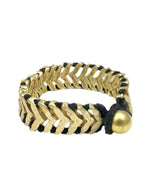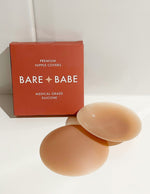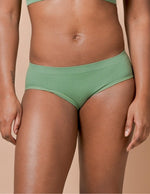
IN THIS ARTICLE
Have you ever purchased a rug or maybe even art for a space in your home only to realize it didn't look how you'd imagined it would? Well I have, too many times to count, and it's never fun to be back at square one.
This is why I started making mood boards before working on any space in my home.
Mood boards have become invaluable to me. They have helped me to see the bigger picture and to be more intentional with the purchases that I make for our home.
What Is A Mood Board, Anyway?
A mood board (or a design board) is a place to collect and organize visual ideas for a creative project. Many creative professionals utilize some form of these inspiration boards.
Pros for making mood boards:
- They are a great starting point for any project.
- Help you to visualize the end result.
- Make decision making easier by letting you compare different options.
- Can save you time and money in the long run.
- Get your creative juices flowing.
- Help creative teams get on the same page (has your significant other ever questioned your paint choice??).
Some reasons, other than an interior design project, that you may want to make a mood board:
- Wedding planning
- Party planning (birthday parties, showers, open houses etc.)
- Wardrobe planning (creating a capsule wardrobe)
- Brand identity (brand style, brand colors and logo design)
The Best Tools To Make A Mood Board
I am going to be talking about how to create a digital mood board for design purposes, but you can also make a physical mood board using a foam board, photographs, paint swatches, fabric samples and other items that inspire you.
There are so many ways to design a digital mood board, so I thought that I would start off by sharing some of my favorite and most frequently used tools for the job.
You do not need to be a professional at graphic design to use any of these things. In fact, you can do everything right from your phone if you'd like.
Pinterest first launched back in 2010. It is the ultimate mood board app when you think about it. Essentially it is a search engine for creatives. It makes it so easy to find, save and share inspiration all in one place. You can organize your ideas into a Pinterest board and sub-boards, plus you can collaborate with friends on Pinterest to build boards together.

Instagram has started to transition into a bit of a search engine as well. It is a great place to find ideas and inspiration for your digital mood board. You can search phrases and hashtags that are related to what you are looking for and save posts you find for later. You can also save posts you see while scrolling your feed. Save an image by tapping the little flag looking button under the right corner of the image.
You can create different folders to organize your saved posts as well, similar to Pinterest.
Here is how to save and organize Instagram posts, if you are not familiar:

Screen Shots
One heavily used tool that most people are familiar with these days is a screen shot. You can take a screen shot on most devices fairly easily. If you are not sure how to so that with your particular laptop/tablet/phone I suggest a quick google search or searching for YouTube videos. It is a fast, easy way to quickly save something you like to your camera roll for later. I screen shot basically everything that I want to include on my mood boards.
Over
Over is a newer, free, graphic design app (or website) that you can use for photo editing and to create design documents. They have pre-made templates for just about anything or you can start from scratch. Over is my go-to moodboard maker.

Canva
Canva is another free digital design tool (both app and website available as well) that has been around for a bit longer. It is very similar to Over and allows you to create documents from scratch or use one of their pre-made template options. I use Canva frequently as well.
Over Vs. Canva
As stated above I use both Over and Canva (though I lean more towards Over as my favorite). Sometimes I use them both on the same mood board/project. It really just depends on what I am doing. I highly suggest playing with each one and seeing what your preference is.
They are both easy to navigate, very similar and you can create a mood board on either program's free version without any issues.

Why I Lean More Towards The Over App
The one thing that truly sets Over apart from Canva for me when making a mood board is the free masking tool. It allows you to erase parts of photos and blend things together more like photoshop. I use this tool on Over almost every single time I start a project now, even if I upload the edited image to Cava after.
Canva does offer a one click background remover tool with it's paid version, but I prefer not to pay for either program so the free masking tool is a huge bonus.

This is just one example of how I use the masking tool to manipulate images while making mood boards. I have zero training in photoshop or graphic design of any kind. I just play around with the masking tool until I have things the way I want them.
My Favorite Mood Board Examples
Creating mood boards has become such a huge part of my design process. I want to share some of the mood boards I have made and how they have served as visual inspiration for the spaces in our home. Mood boards can be as simple or complex as you would like them to be. As you can see below, I do not use any sort of mood board template. I personally like to start with a blank white page and build a photo collage.
Example #1: Daughter's Bedroom
This is one of the first mood boards that I ever created, and I have continued to fine tune it while I work on her space. It will probably change again before I finish this space up. Her colorful room is way out of my interior design comfort zone, and it has been so helpful to play around with different design ideas before committing.

You can see I have an actual photo of her room included on the board. I also added screen shots of all the art I have in her room and have used the art to pull in more colors to the mood board while shopping for bedding and rugs.
Example #2: Kitchen Refresh
For me, this was the perfect mood board. I used the masking tool on Over (I'm telling you, it's a great tool) to piece together my design idea for our banquette bench build.
I turned my vision into this mood board and then brought my mood board to life. I have a highlight reel saved showing a screen recording of me making this mood board. You can find it here, under Mood Board.

I also included photos of the space, decor items I have as well as items I want to add to make sure I loved everything together.
Here is how the banquette turned out:

Example #3: Electric Fireplace
This was the mood board I created for our living room and our electric fireplace project last winter. As you can see I added an image of our sofa that we have had for a few years (erased the background of it) and then started playing with rugs, art and a fireplace design to go with it.

Example #4: Gallery Wall
Mood boards don't always have to be complex. Here is an example of a simple mood board I made with digital art prints for our recent bedroom refresh. I was able to see what art worked well together and what did not before purchasing the files. Unlike the last three mood boards that included many other details about the space, this was only to get an idea of exactly what art I wanted to pair together.

How To Make A Moodboard In 8 Simple Steps
Here is a step by step guide on how you can create your mood board exactly like designers do. Step one is not 100% necessary, but I find it extremely helpful when picking out design elements for my space. It gives me a better sense of direction.
Step 1: Make a Pinterest Board
Whenever I start on a new space (like a bedroom) I make a Pinterest board for it and start pinning rooms I like to that inspiration board. As I am scrolling I try not to overthink things. If my first reaction to a photo is that I like it, then I pin it.

After I've gotten a good amount of pins saved to my inspiration board, I go back and look at all of them to find a common theme. Did I mostly pin the same style (modern, boho, farmhouse..) or a lot of the same color schemes? These trends are usually where I start with picking things out for my mood board.

This step is especially helpful when I need some new ideas.
Step 2: Browse Your Favorite Shopping Sites
When you create a mood board for an interior design project you usually include images of items that you are considering adding to the space.
Visit your favorite shops and start taking screenshots of items that you love that may work with your space.

A pro tip for you: When you are shopping make sure you either A. favorite items if you are logged into an account or B. start a Word document to compile a list of links to the items you've screen shot. This way they are easy to find again. Trust me, after you've browsed/considered dozens of rugs across a handful of sites, you will be glad you saved your favorites.
Step 3: Create A Blank Template on Over or Canva
Once you've compiled some inspiration photos and found decor elements you love, open up your choice of design software so you can begin making your mood board. I am going to use Over (remember the masking tool I mentioned earlier) for this mood board tutorial but Canva is almost identical. Start with a blank document. With both programs you will have a choice of document size. I almost always pick a white, 3x4 image to start with.

Step 4: Insert Photos of The Space You Are Working On
First I add images to my mood board of my current space. It's just nice to see your own photos of the space you are working with included in the collage. On Over you select the Image icon in the bottom left corner and then select your camera roll in order to pull images saved on your device.
I usually just drag and drop the images to a corner of my mood board to start with.

Step 5: Insert Inspiration Photos
Now it's time to add one or two inspiration images to your mood board. It is up to you what you use, but I love to add one or two of my absolute favorite images from the Pinterest mood board that I created to try and really capture the vibe I am going for. I don't always add my inspiration photos to my mood board though and that's okay too.
Step 6: Add Photos of Items You already Have and Plan to Use
After adding inspiration photos, I start adding images of items that I already own and plan to use in the space. If I can find stock images of those items online then I use those. If not I take a photo of the item myself and add it in. Again drag and drop these images wherever you'd like.

If you need to remove the background of anything, select the image by double tapping it, and the edit toolbar should pop up at the bottom. Scroll the tools all the way to the right until you see the masking tool. I like to use the soft brush because it gives a more blended edge around the item you are isolating. The app lets you pinch and zoom in on the image you are editing to make it easier to go around small details with the masking brush.
Step 7: Add Screenshots of Other Items You'd Like to Add to The Space
The final images I add to my mood boards are the screen shots of items I am considering purchasing. Again, remove the background of any of the images you think necessary and simply drag the photos around until you are happy with how they are arranged.
Include any new elements you are considering. Bedding, wall art, tile, cabinet hardware.. add as many details as you can to your collage during this step. You can also add in things like color swatches to help you pick a color palette, as well as descriptive words.

As you get more elements on your mood board you can easily edit their layers and how they overlap by selecting the little button up top that looks like a stack of squares. This makes it easy to bring images forward or to the back of the document so that they overlap appropriately.
Step 8: Create Multiple Moodboards For The Space
If you are having trouble deciding on any design elements, create multiple mood boards for the space. This is such a great visual tool for purchasing items, and allows you to showcase what the space might look like with different combinations of items.

The easiest way I have found for doing this is to save/download the first version of the mood board and then go back in and change out the items you are debating on. Save the new versions as well and then you can compare all of the mood boards at the same time.

I like to leave my finished digital moodboard to my personal collection of projects on the app, this way I can easily go back and revisit my ideas as time goes on.
A Quick Recap on Digital MoodBoards:
Digital moodboards are a collage of images that give you a visual representation of how you want to style a space. They make it easy to achieve a consistent look like professional designers and you do not need a special moodboard template to create one.
Whether you are creating a wedding mood board, a fashion mood board or working on branding ideas, the steps listed above are a great way to find inspiration for your project.
I hope you have enjoyed this look into my creative process! Let us know below if you plan to create mood boards for your upcoming projects.
More from Sozy:
- The Easiest Indoor Vine Plants
- How to Make DIY Acrylic Wall Calendar (And Mistakes to Avoid)
- An Indoor Herb Garden Anyone Can Start
- How To Make Your Place a Live/Work/Thrive Sanctuary
- How to Make Your Bed Even Better
- Natural Ways to Bring More Light Into Your Room
- 5 Houseplants That Do More Than Look Pretty
- 7 Must Have Wall Desks for Working at Home
- 8 Easy Interior Design Tips for Small Spaces
























 TOP
TOP



